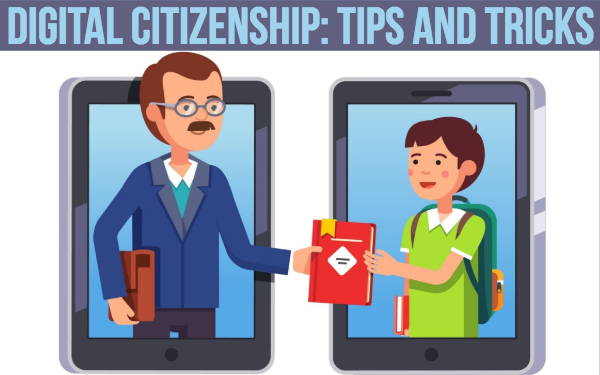The ultimate teacher guide to teaching students digital citizenship
 Sophia Anderson —
Sophia Anderson —
The term digital citizenship has become fairly common in modern-day discourse and is now part of our reality. And yet, despite its importance, it still isn’t widely taught in our schools.
In this guide, you’ll learn everything you need to know about digital citizenship. I’ll touch these essential topics:
- What is digital citizenship?
- Understanding the why of digital citizenship
- The 9 elements of digital citizenship
- The essentials to teach students digital responsibility
- Tips to help you teach digital citizenship to your students
- Sites and resources to learn about digital citizenchip
Click on the link to go to your favourite part in the text.
What is digital citizenship?
According to Wikipedia “A digital citizen refers to a person utilizing information technology to engage in society, politics, and government.” K. Mossberger defines digital citizens as “those who use the Internet regularly and effectively,”.
I remember listening to a talk by the famous inventor and futurist, Ray Kurzweil, one day. He likened modern technology to an extension of various human body parts and functions. In a way, that’s true. If, for example, a power drill is a specialized extension of our hands, then our phones and the internet are extensions of our brains. They are as much a part of us as our very personalities. We use them to think, when we Google solutions to our problems, to learn new things, and, with the advent of social media, to interact with the world at large.
With the internet occupying an ever-expanding role in our lives, it is necessary to prepare our children to live with it early enough. Our daily life is becoming ever more digitalized, and our children interact more and more with content, each other and social communities online.
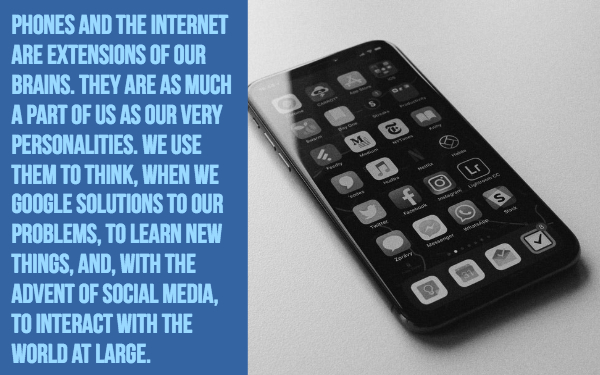
Understanding the why of digital citizenship
To begin with, education itself is a social institution. It is all but one of the basic human needs at this point, right up there with food, shelter, and clothing. It is through the educational system that we impart our societal values into the next generation and mold them to be able to bring to fruition the better future we all envision.
It would, therefore, make sense that we would make better digital citizens of our young ones. And there are even more reasons to promote a good education in digital citizenship:
1. Technology gap
There is already a wide gap between the pace at which technology is moving and its rate of implementation in our curriculum. Of course, not all of these technologies will last, some of them being nothing more than fads, but there are many that will persist and are still as yet far ahead of our curriculum. The problem is that, despite being taught according to one set of paradigms at school, students live by a totally different set of paradigms. They are constantly devouring new technologies, and school should be a guiding light for them, showing them how to best survive in this ever-evolving world.
2. Digital footprint
It’s fairly obvious that lots of colleges aren’t just satisfied with your GPA anymore. They now look at your digital footprint. From your tweets to your Instagram and Facebook profiles, your online persona is just as important to your social reputation as your persona in the physical world. With a good education about how to create a healthy online profile early on, the current generation will be adequately prepared for the job market of tomorrow.
3. Multitasking epidemic
The internet has brought with it what some would consider a multitasking epidemic. Our children are getting better and better at shuffling between tabs and windows; texting and reading; tweeting and researching. And yet, just as multitasking becomes more prominent, so do the results of research showing that it isn’t the most effective way to work. By teaching the importance of mindfulness and undivided attention to our kids early, and showing them how to better manage their time online, we will give them a better chance at excelling in their future academics, benefitting from, rather than losing to their digital pursuits.
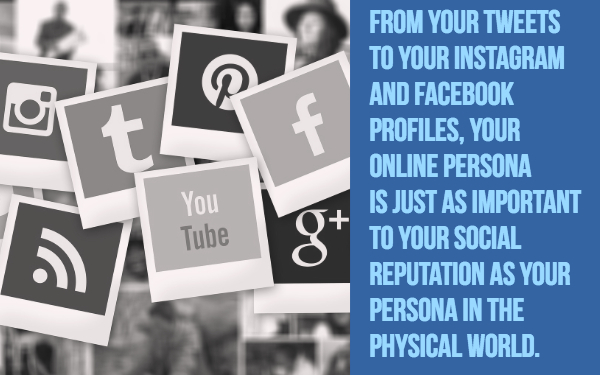
The 9 elements of digital citizenship
According to digitalcitizenship.net, there are 9 elements, or themes, to digital citizenship. All of these should somehow be incorporated into a curriculum on digital citizenship, so we can teach our students some digital responsibilty.
1. Digital Access
 Digital access is the principle of ensuring that everyone has access to digital resources. As a teacher, you will recognize that not all your students will have equal access to the digital resources you direct them to. Your goal should, therefore, be to help provide them with access to these digital resources so that they are on an equal footing with their peers.
Digital access is the principle of ensuring that everyone has access to digital resources. As a teacher, you will recognize that not all your students will have equal access to the digital resources you direct them to. Your goal should, therefore, be to help provide them with access to these digital resources so that they are on an equal footing with their peers.
2. Digital commerce
 A significant part of commerce is conducted online today. This involves selling and buying both lawful and unlawful goods and services. That means that, while there will be obvious advantages to purchasing goods and pay for services online, there will also be dangers associated with coming into contact with illegal goods and services. As a teacher, you should teach your students to be discerning consumers in the digital economy.
A significant part of commerce is conducted online today. This involves selling and buying both lawful and unlawful goods and services. That means that, while there will be obvious advantages to purchasing goods and pay for services online, there will also be dangers associated with coming into contact with illegal goods and services. As a teacher, you should teach your students to be discerning consumers in the digital economy.
3. Digital Communication
 Communication has seen an explosion in bandwidth since the 19th century. Where we were limited in the methods with which we could communicate less than a century ago, we now have what seems like countless options to keep in touch with each other. It is possible to keep in touch with people who are close to us virtually every minute every day. And yet, with all these options, not all of us are well educated in the appropriate ways to use different communication channels. It is your duty as a teacher to ensure your students have enough education on ways to fully utilize the various avenues of communication available to them.
Communication has seen an explosion in bandwidth since the 19th century. Where we were limited in the methods with which we could communicate less than a century ago, we now have what seems like countless options to keep in touch with each other. It is possible to keep in touch with people who are close to us virtually every minute every day. And yet, with all these options, not all of us are well educated in the appropriate ways to use different communication channels. It is your duty as a teacher to ensure your students have enough education on ways to fully utilize the various avenues of communication available to them.
4. Digital Literacy
 Despite a concerted effort by our education system to keep up with the burgeoning technological tools coming up every day, there is still a significant gap between what students learn to use in school and what workplaces are adopting as work tools. From videoconferencing to shared workspaces to information literacy, there is a need to bring our students up to speed with the technologies used in the workplace in order to make them more effective professionals in the future.
Despite a concerted effort by our education system to keep up with the burgeoning technological tools coming up every day, there is still a significant gap between what students learn to use in school and what workplaces are adopting as work tools. From videoconferencing to shared workspaces to information literacy, there is a need to bring our students up to speed with the technologies used in the workplace in order to make them more effective professionals in the future.
5. Digital Etiquette
 Digital etiquette can be argued to be one of the most important themes of digital citizenship in the modern day. Most of us can quickly recognize inappropriate behavior when it is being perpetrated online, but there isn’t any solid base of education on how to behave in a digital social situation. A better educated digital citizen will be able to apply the same standards of ethics online that they comfortably apply offline.
Digital etiquette can be argued to be one of the most important themes of digital citizenship in the modern day. Most of us can quickly recognize inappropriate behavior when it is being perpetrated online, but there isn’t any solid base of education on how to behave in a digital social situation. A better educated digital citizen will be able to apply the same standards of ethics online that they comfortably apply offline.
6. Digital Law
 Digital law is all about how legally technology is used by members of the society. Just as thefts, damage to property and slander are crimes offline, so they are online. Our students need to be taught about digital law and encouraged to uphold it in their daily digital pursuits.
Digital law is all about how legally technology is used by members of the society. Just as thefts, damage to property and slander are crimes offline, so they are online. Our students need to be taught about digital law and encouraged to uphold it in their daily digital pursuits.
7. Digital Rights and Responsibilities
 Just as we have rights and responsibilities offline, so do we have the same online. Such things as an individual’s right to freedom of speech, privacy, and so on should be upheld online with the same sanctity as they are upheld offline. However, these rights come with attendant responsibilities that we must also uphold, such as respecting the rights of others to privacy and freedom of speech. In a well-developed digital society, these rights and responsibilities will work together to promote productivity.
Just as we have rights and responsibilities offline, so do we have the same online. Such things as an individual’s right to freedom of speech, privacy, and so on should be upheld online with the same sanctity as they are upheld offline. However, these rights come with attendant responsibilities that we must also uphold, such as respecting the rights of others to privacy and freedom of speech. In a well-developed digital society, these rights and responsibilities will work together to promote productivity.
8. Digital Health and Wellness
 Such things as ergonomic considerations, the promotion of eye safety, and the prevention of internet addiction are just as important as all the others discussed here. A good course on digital citizenship will encourage your students to take care of their own health and psychological wellness as they engage with the internet.
Such things as ergonomic considerations, the promotion of eye safety, and the prevention of internet addiction are just as important as all the others discussed here. A good course on digital citizenship will encourage your students to take care of their own health and psychological wellness as they engage with the internet.
9. Digital Security
 Self-protection is as necessary in the online world as it is offline. Despite many laws governing our digital citizenship, there are still many individuals who will readily steal, damage, and slander online. As a teacher, you should teach your students to protect themselves against such individuals, taking precautions to safeguard their privacy, documents, and computer networks, whether at home or at school.
Self-protection is as necessary in the online world as it is offline. Despite many laws governing our digital citizenship, there are still many individuals who will readily steal, damage, and slander online. As a teacher, you should teach your students to protect themselves against such individuals, taking precautions to safeguard their privacy, documents, and computer networks, whether at home or at school.
Together, these nine elements make for a complete digital citizenship course that will form productive digital students of the future.
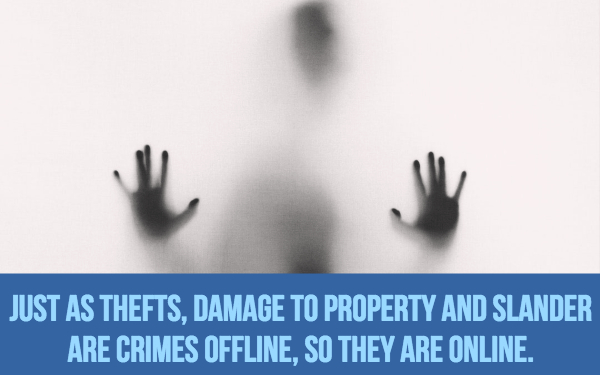
The essentials to teach students digital responsibility
As you formulate a curriculum on digital citizenship, there are certain basics you should touch upon:
- Privacy protection. This involves the use of strong passwords and the avoidance of interaction with strangers online.
- Oversharing. Younger people are naturally more vulnerable and prone to self-revealing and oversharing online. A good course on digital citizenship should teach them what information it is appropriate to share online, and with whom.
- Cyberbullying. As a growing phenomenon in schools, this new form of bullying can best be combatted by teaching our students how to effectively deal with it.
- Positive footprints in the digital age. With the explosion of social media, it’s important to teach our students the importance of crafting a positive online persona and show them how to do it through our digital citizenship programs.
- Respectful communication online and voicing of one’s own opinion. Netiquette is an important part of being a digital citizen and should be taught to our students from a young age.
- Evaluating online information/website credibility. Digital citizenship literacy enables digital citizens to correctly curate informational content they find online and correctly evaluate the credibility of the websites from which they obtain their information.
- Copyright and plagiarism issues. This involves teaching our students not to take the work of others and pass it off as their own. Showing them how to credit their sources will teach them to better uphold digital ethics by respecting the original work of others.
- Consequences of non-abiding by digital rules. With the growth of legislation on digital crimes, our students should be taught where the line is on many issues involving digital conduct so that they can intimately understand the consequences of breaking these digital rules.
Tips to help you teach digital citizenship to your students
- Incorporate digital citizenship lessons into daily studies. For example, after teaching on a particular topic in history, offer your students important links to credible sites where they can learn more about the topic. Remind them how to check the credibility of sites from which they obtain their information. When giving them assignments, particularly essay assignments, remind them to always credit their sources.
- Educate yourself. Many educators feel like they don’t know enough about digital citizenship themselves to be able to effectively teach it. You can look at the sources at the end of this article to learn some more about digital citizenship so you can be better at it.
- Be a role model. Implement the very things you teach about digital citizenship so your students can emulate you.
- Create a digital toolkit of “Dos and Don'ts” that you keep in site of your students at all times in order to ingrain the rules of digital ethics in them.
- Engage with your students in debates and discussions regularly about real digital citizenship cases and issues to encourage them to explore and formulate their own opinions on the matter.
- Work closely with parents and encourage them to be responsible digital citizens themselves. Work to prepare projects with your students that they can then present to their parents.
- Align the activities with the grade of your students. You can find helpful tips for doing this here.
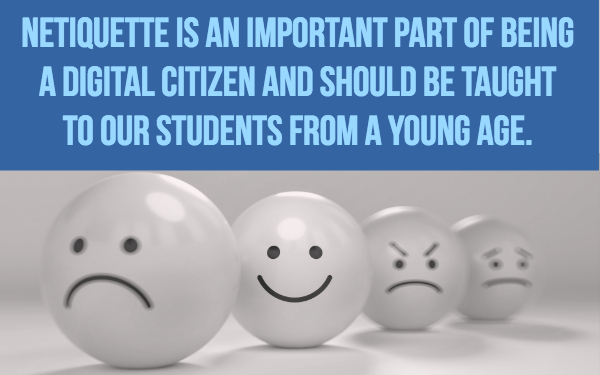
Sites and resources to learn about digital citizenchip
These resources help you both learn and teach the various aspects of digital citizenship in connection to the nine elements we discussed above. Go through them and familiarize yourself with as many aspects of digital citizenship as you can.
- Digital Citizenship & K-12 Program by Common Sense Education – This is a full course on digital citizenship for the K-12 program with over 60 lesson plans differentiated by grade. If you’re looking to craft a curriculum on digital citizenship for your class, this is a good place to start.
- BeInternetAwesome with Google – This great project by Google is based on the fictional land of Interland, where your students get to learn to be fearless explorers of the internet. It’s a fun way to learn digital citizenship that your students are bound to enjoy.
- NetSmartKids – This website is part of a program by the National Center for Missing and Exploited Children. It’s an educational program seeking to teach children between the ages of 5 and 17 to practise better safety online.
- Digital Compass by Common Sense Media – This is an iPhone app designed as a choose-your-own-adventure game. It’s designed for kids between 6th and 9th grade and aims at teaching them to navigate daily digital life.
- Digital Passport – Digital Passport is another comprehensive online resource to help you craft your digital citizenship curriculum for 3rd to 5th graders. It contains a series of games and tests that home in on critical skills to help children maneuver through the digital world.
- 7 Deadly Digital Sins – This is an interactive website with confession videos representing the 7 deadly sins committed online. It’s a pretty cool way of showing children in higher grades how easy it is to fall into the pitfalls of the online world.
- BrainPop: Digital Citizenship – Brain Pop is the final comprehensive resource on this list. Some of the lessons are free while others have to be paid for. It’s pretty cool, though, since you can do anything from playing games, completing quizzes, watching movies or coding, all to help learn the different lessons. It’s a great way to get the message of digital citizenship.
- Digital security resources and guides - This website has a guide with all the resourses you need to make sure you keep your privacy using the internet and other software programs. It might help you with setting up a safe digital classroom evironment for your students.
We are taught to be good citizens from a young age. It is intimately integrated into every aspect of our education. In the future, however, we will not only be physical citizens but digital ones as well. It, therefore, behooves us to make digital citizenship a part of our curriculum. Only then can we craft a digital future we will be proud of.
Share this blog post with your colleagues and spread the message!
About the author
Sophia Anderson is an associate educator, blogger and freelance writer at EduGeeksClub She is passionate about covering topics on learning, writing, business, careers, self-improvement, motivation and others. She believes in the driving force of positive attitude and constant development. Feel free to get in touch on Twitter.

